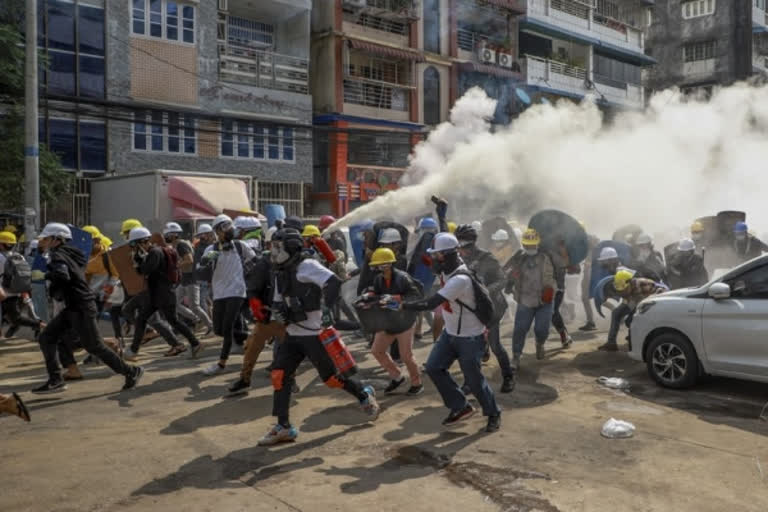Yangon: Myanmar security forces were seen firing slingshots at protesters, chasing them down and even brutally beating an ambulance crew in video showing a dramatic escalation of violence against opponents of last month’s military coup.
A U.N. official speaking from Switzerland said 38 people had been killed Wednesday, a figure consistent with other reports though accounts are difficult to confirm inside the country. The increasingly deadly violence could galvanize the international community, which has responded fitfully so far.
“Today it was the bloodiest day since the coup happened on Feb. 1. We have today — only today — 38 people died. We have now more than over 50 people died since the coup started” and more have been wounded, the U.N. special envoy for Myanmar, Christine Schraner Burgener, told reporters at U.N. headquarters on Wednesday.
Demonstrators have regularly flooded the streets of cities across the country since the military seized power and ousted the elected government of leader Aung San Suu Kyi. Their numbers have remained high even as security forces have repeatedly fired tear gas, rubber bullets and live rounds to disperse the crowds, and arrested protesters en masse.
Read: UN Human Rights Office says 18 dead in Myanmar crackdown
The intensifying standoff is unfortunately familiar in a country with a long history of peaceful resistance to military rule — and brutal crackdowns. The coup reversed years of slow progress toward democracy in the Southeast Asian nation after five decades of military rule.
The Democratic Voice of Burma, an independent television and online news service, also tallied 38 deaths. A toll of at least 34 was compiled by a data analyst in Yangon, Myanmar’s biggest city, who spoke on condition of anonymity because he feared for his safety. He also collected information where he could on the victims’ names, ages, hometowns, and where and how they were killed — an effort he said he had made to honor those who were killed for their heroic resistance.
The Associated Press was unable to independently confirm most of the reported deaths, but several square with online postings.
According to the data analyst’s list, most were in Yangon, where 18 died. In the central city of Monywa, which has turned out huge crowds, eight deaths were reported. Three deaths were reported in Mandalay, the country’s second-biggest city, and two in Salin, a town in Magwe region. Mawlamyine, in the country’s southeast, and Myingyan and Kalay, both in central Myanmar, each had a single death.
As part of the crackdown, security forces have also arrested hundreds of people, including journalists. On Saturday, at least eight journalists, including Thein Zaw of The Associated Press, were detained. A video showed he had moved out of the way as police charged down a street at protesters, but then was seized by police officers, who handcuffed him and held him briefly in a chokehold before marching him away.
Read: Myanmar police fire tear gas, rubber bullets at protesters
He has been charged with violating a public safety law that could see him imprisoned for up to three years.
The escalation of the crackdown has led to increased diplomatic efforts to resolve Myanmar’s political crisis — but there appear to be few viable options. It’s not yet clear if Wednesday’s soaring death toll could change the dynamic.
The U.N. Security Council is expected to hold a closed meeting on the situation on Friday, council diplomats said, speaking on condition of anonymity because they were not authorized to make the information public before the official announcement. The United Kingdom requested the meeting, they said.
Still, any kind of coordinated action at the United Nations will be difficult since two permanent members of the Security Council, China and Russia, would almost certainly veto it. Some countries have imposed or are considering imposing their own sanctions.
The U.N. special envoy, Schraner Burgener, who supports sanctions, said she receives some 2,000 messages per day from people inside Myanmar, many “who are really desperate to see action from the international community.”
The 10-member Association of Southeast Asian Nations, which includes Myanmar, issued a statement after a teleconference meeting of foreign ministers Tuesday that merely called for an end to violence and for talks on how to reach a peaceful settlement. ASEAN has a tradition of non-interference in each other’s internal affairs.
Ignoring that appeal, Myanmar’s security forces have continued to attack peaceful protesters.
In addition to the deaths, there have been reports of other violence. In Yangon, a widely circulated video taken from a security camera showed police in the city brutally beating members of an ambulance crew — apparently after they were arrested. Police can be seen kicking the three crew members and thrashing them with rifle butts.
Read: Reports: Myanmar security forces kill at least 33 protesters
Security forces are believed to single out medical workers for arrest and mistreatment because members of the medical profession launched the country’s civil disobedience movement to resist the junta.
In Mandalay, riot police, backed by soldiers, broke up a rally and chased around 1,000 teachers and students from a street with tear gas as gun shots could be heard.
Video from the AP showed a squad of police firing slingshots in the apparent direction of demonstrators as they dispersed.
AP



